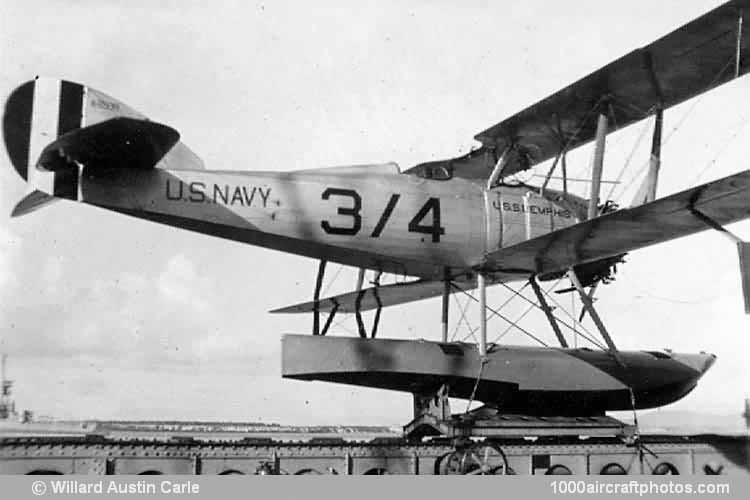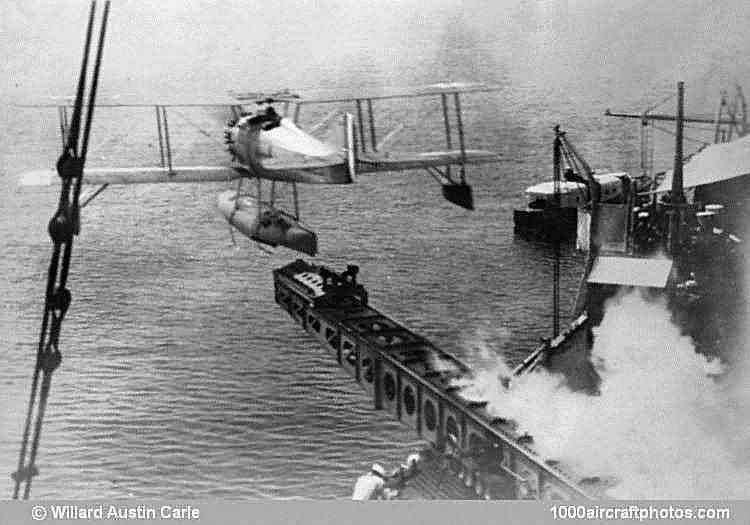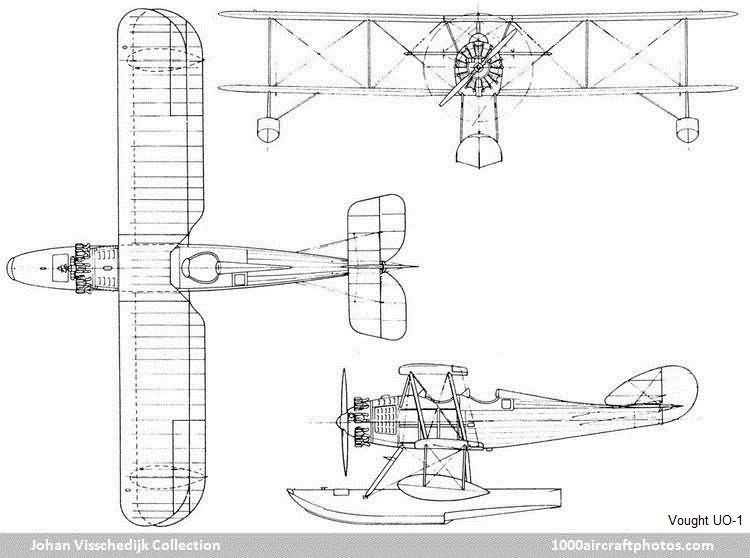02/28/2014. Remarks by Johan Visschedijk: "This other photo of the aircraft, not the clearest, but quite dramatic, shows the catapult-launch of the UO-1 on August 5, 1926. The launch was observed by the Spanish Royal Family off the coast near Santander on the Spanish north coast. The USS Memphis toured Europe during 1926-1927, however, it is better known as the ship that brought Charles Lindbergh and his "Spirit of St. Louis" back to the USA after the historic trans-Atlantic flight in May 1927.
The Vought UO-1, of which 141 were built, was an improved VE-7 given a standardized Naval designation after the new designation system was adopted in 1921. The new design was originally intended for the fighter role then filled by the VE-7SF and was given the designation of UF-1 (U for Vought in place of the logical letter V since the latter was assigned to all aeroplanes as a class). However, since more specialized fighters were then under development, the new Voughts were reclassified and became unarmed observation types.
The UO-1 airframe was identical with that of the VE. Wings and horizontal tail surfaces were interchangeable. Streamlining was improved by rounding out the fuselage with formers and stringers, and the space for the observer in the front cockpit was increased by installing cheek-type fuel tanks on each side of the cockpit, outside the basic fuselage structure, where they matched the contours of the added formers. Access to the front cockpit was greatly improved by a revision of the center section strut arrangement to eliminate the cross-bracing wires that blocked each side of the cockpit and made it necessary to enter and leave by the rear instead of the side.
Other than the rounded fuselage and a different power plant, the principal departure from the VE was the use of an entirely new shape for the vertical tail surfaces. The added area made it unnecessary to use a different fin for the seaplane versions. The various modifications to the VE airframe that resulted in the UO-1 design were worked out and tested on the VE-9 with BuNo. A-6478.
The UO-1 was originally intended to use the 250 hp Aeromarine U-873 engine, but a Navy decision to use only air-cooled engines for subsequent fleet aircraft up to 300 hp resulted in a decision to re-engine the UO-1 with the new 200 hp Lawrance J-1, a nine-cylinder air-cooled radial that became the Wright J-1 when the Lawrance Aero Engine Corporation became part of the Wright Aeronautical Corporation. The loss of performance resulting from the decrease in power was largely compensated by the lighter weight of the air-cooled unit. From 1927 on, many UO-1s had their original Wright/Lawrance J-1s or J-3s replaced by the new 220 hp Wright J-5, which, as the Whirlwind, was destined to become one of the most famous air-cooled radials ever built.
The 19th UO, which had been completed with the original Aeromarine engine, was stripped down by the Navy to the basic flat-sided VE fuselage and was used as a single-seat racer under the designation of UO-2. French Lamblin radiators, widely used on racers of the period, were used in place of the traditional Spad nose radiator of the YEs. After the UO-2 was out-classed as a racer, it was reconverted to a two-seater with the 180 hp Wright-Hispano E and was assigned to utility work. It retained the Lamblin radiators, which were moved up from between the landing gear struts to a position above the lower wing on each side of the front cockpit.
Float-equipped UO-1s replaced the YEs on the ships of the fleet. Those which were specially reinforced for catapult launching were designated UO-1C, but under the new standardized designation system, no distinction was made between landplane and seaplane versions of the same design. Other UO-1s were fitted with arrester hooks for operation from aircraft carriers.
Following their replacement as first-line fleet equipment, the UO-1s were used for a great variety of utility, training and experimental duties long beyond the service life of their contemporaries. One was fitted with a skyhook above the center section and was used for the Navy's first experiments in hooking an aeroplane to and releasing it from an airship in flight.


